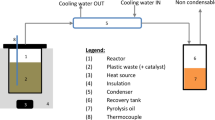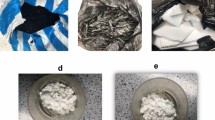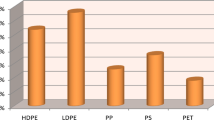Abstract
Valuable petrochemicals such as benzene, toluene, and xylenes have been observed in waste tyre-derived oils, indicating that waste tyre exhibits its potential to be used for an alternative source for sustainably producing petrochemicals. However, without a catalyst, such chemicals cannot be produced in a high amount. Sulfur compounds causing environmental problems and the low quality of oils were also found in tyre-derived oils. In waste tyre pyrolysis, zeolites that have been used very often to improve the quality of oil are HZSM-5 and HY, owing to their cracking and single-ring aromatics-producing abilities. Some other zeolites have been also employed occasionally, but the effects of zeolite properties on the hydrocarbon species and sulfur compounds in oils have not been explained clearly. The objective of this work was therefore to investigate the effects of zeolite properties, that are, acidity/basicity, pore channel structure, pore size, and Si/Al ratio on hydrocarbon species in pyrolysis products, especially valuable C6–C8 petrochemicals and sulfur compounds. The oils were analyzed using SIMDIST-GC for petroleum fractions and using a GC × GC–TOF/MS for valuable petrochemicals and sulfur-containing compounds. The analysis of the results from using five zeolites indicated that, for high production of valuable C6–C8 petrochemicals from waste tyre pyrolysis, a catalyst must (a) possess acid sites, rather than basic ones, that have high enough strength for cracking, which can result in high production of naphtha fraction and (b) have a complex channel structure with a large enough pore size (at least ~7 Å) that allows molecules to stay inside at a long contact time. In addition, high acid strength is more preferred to high acid density for high production of valuable C6–C8 petrochemicals, but high acid density is more preferred for production of oil with low sulfur content.







Similar content being viewed by others
References
Banar M, Akyıldız V, Özkan A, Çokaygil Z, Onay Ö (2012) Characterization of pyrolytic oil obtained from pyrolysis of TDF (Tyre Derived Fuel). Energy Convers Manag 62:22–30
Boxiong S, Chunfei W, Binbin G, Rui W, Cai L (2007a) Pyrolysis of waste tyres with zeolite USY and ZSM-5 catalysts. Appl Catal B 73:150–157
Boxiong S, Chunfei W, Cai L, Binbin G, Rui W (2007b) Pyrolysis of waste tyres: the influence of USY catalyst/tyre ratio on products. J Anal Appl Pyrol 78:243–249
Cottrell TL (1958) The strengths of chemical bonds. Butterworth Scientific Publication, London
Cypres R (1987) Aromatic hydrocarbons formation during coal pyrolysis. Fuel Process Technol 15:1–15
Dũng NA, Wongkasemjit S, Jitkarnka S (2009) Effects of pyrolysis temperature and Pt-loaded catalysts on polar-aromatic content in tyre-derived oil. Appl Catal B 91(1–2):300–307
Fiksel J, Bakshi BR, Baral A, Guerra E, DeQuervain B (2011) Comparative life cycle assessment of beneficial applications for scrap tires. Clean Technol Environ Policy 13:19–35
García-Cruz I, Valencia D, Klimova T, Oviedo-Roa R, Martínez-Magadán JM, Gómez-Balderas R, Illas F (2008) Proton affinity of S-containing aromatic compounds: implications for crude oil hydrodesulfurization. J Mol Catal A 281(1–2):79–84
Hancsók J, Eller Z, Pölczmann G, Varga Z, Holló A, Varga G (2014) Sustainable production of bioparaffins in a crude oil refinery. Clean Technol Environ Policy 16:1445–1454
Islam MR, Haniu H, Rafiqul Alam Beg M (2008) Liquid fuels and chemicals from pyrolysis of motorcycle tyre waste: product yields, compositions and related properties. Fuel 87(13–14):3112–3122
Joshi YV, Thomson KT (2005) Embedded cluster (QM/MM) investigation of C6 diene cyclization in HZSM-5. J Catal 230(2):440–463
Meng X, Wang Z, Zhang R, Xu C, Liu Z, Wang Y, Guo Q (2013) Catalytic conversion of C4 fraction for the production of light olefins and aromatics. Fuel Process Technol 116:217–221
Mikulec J, Vrbova M (2008) Catalytic and thermal cracking of selected polyolefins. Clean Technol Environ Policy 10:121–130
Moqadam SI, Mirdrikvand M, Roozbehani B, Kharaghani A, Shishehsaz MR (2015) Polystyrene pyrolysis using silica-alumina catalyst in fluidized bed reactor. Clean Technol Environ Policy. doi:10.1007/s10098-015-0899-8
Muenpol S, Jitkarnka S (2014) Impact of zeolite channel structure on structure of hydrocarbon compounds and petrochemicals in waste tyre-derived oils. Chem Eng Trans 39:685–690
Olazar M, Aguado R, Arabiourrutia M, Lopez G, Barona A, Bilbao J (2008) Catalyst effect on the composition of tyre pyrolysis products. Energy Fuel 22(5):2909–2916
Pakdel H, Pantea DM, Roy C (2001) Production of dl-limonene by vacuum pyrolysis of used tyres. J Anal Appl Pyrol 57:91–107
Pithakratanayothin S, Jitkarnka S (2014) Comparison of components in oil derived from tyre pyrolysis with and without KL catalyst using GC × GC/TOF–MS. Chem Eng Trans 39:1261–1266
Rigby AM, Frash MV (1997) Ab initio calculations on the mechanisms of hydrocarbon conversion in zeolites: skeletal isomerisation and olefin chemisorption. J Mol Catal A Chem 126(1):61–72
Roldán R, Romero FJ, Jiménez C, Borau V, Marinas JM (2004) Transformation of mixtures of benzene and xylenes into toluene by transalkylation on zeolites. Appl Catal A 266(2):203–210
Roozbehani B, Sakaki SA, Shishesaz M, Abdollahkhani N, Hamedifar S (2015) Taguchi method approach on catalytic degradation of polyethylene and polypropylene into gasoline. Clean Technol Environ Policy. doi:10.1007/s10098-015-0901-5
Sakaki SA, Roozbehani B, Shishesaz M, Abdollahkhani N (2014) Catalytic degradation of the mixed polyethylene and polypropylene into middle distillate products. Clean Technol Environ Policy 16:901–910
Srogi K (2008) An overview of current processes for the thermochemical treatment of automobile shredder residue. Clean Technol Environ Policy 10:235–244
Sudha S, Palanichamy M, Arabindoo B, Murugesan V (2007) Unsymmetrical alkylation of benzene over large pore zeolites. Catal Commun 8(7):1137–1144
Williams PT, Bottrill RP (1995) Sulfur-polycyclic aromatic hydrocarbons in tyre pyrolysis oil. Fuel 74(5):736–742
Williams PT, Brindle AJ (2002) Catalytic pyrolysis of tyres: influence of Tyres: influence of catalyst temperature. Fuel 81:2425–2434
Williams PT, Brindle AJ (2003a) Aromatic chemicals from the catalytic pyrolysis of scrap tyres. J Anal Appl Pyrol 67:143–164
Williams PT, Brindle AJ (2003b) Temperature selective condensation of tyre pyrolysis oils to maximize the recovery of single ring aromatic compounds. Fuel 82:1023–1031
Acknowledgments
The authors would like to gratefully thank Thailand Research Fund (TRF) (Grant Number RSA5680021).
Author information
Authors and Affiliations
Corresponding author
Rights and permissions
About this article
Cite this article
Muenpol, S., Yuwapornpanit, R. & Jitkarnka, S. Valuable petrochemicals, petroleum fractions, and sulfur compounds in oils derived from waste tyre pyrolysis using five commercial zeolites as catalysts: impact of zeolite properties. Clean Techn Environ Policy 17, 1149–1159 (2015). https://doi.org/10.1007/s10098-015-0935-8
Received:
Accepted:
Published:
Issue Date:
DOI: https://doi.org/10.1007/s10098-015-0935-8




